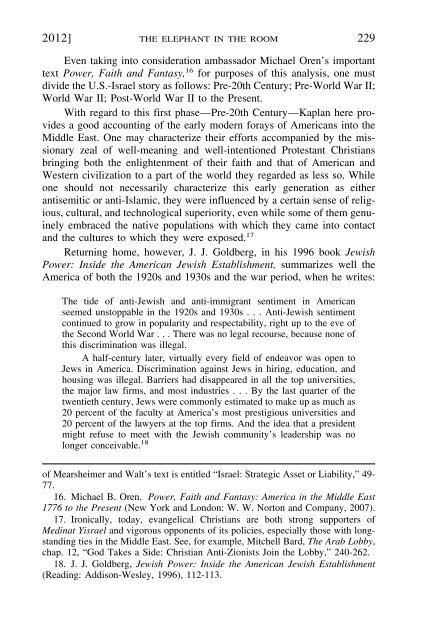Volume 4 No 1 - Journal for the Study of Antisemitism
Volume 4 No 1 - Journal for the Study of Antisemitism
Volume 4 No 1 - Journal for the Study of Antisemitism
Create successful ePaper yourself
Turn your PDF publications into a flip-book with our unique Google optimized e-Paper software.
2012] THE ELEPHANT IN THE ROOM 229<br />
Even taking into consideration ambassador Michael Oren’s important<br />
text Power, Faith and Fantasy, 16 <strong>for</strong> purposes <strong>of</strong> this analysis, one must<br />
divide <strong>the</strong> U.S.-Israel story as follows: Pre-20th Century; Pre-World War II;<br />
World War II; Post-World War II to <strong>the</strong> Present.<br />
With regard to this first phase—Pre-20th Century—Kaplan here provides<br />
a good accounting <strong>of</strong> <strong>the</strong> early modern <strong>for</strong>ays <strong>of</strong> Americans into <strong>the</strong><br />
Middle East. One may characterize <strong>the</strong>ir ef<strong>for</strong>ts accompanied by <strong>the</strong> missionary<br />
zeal <strong>of</strong> well-meaning and well-intentioned Protestant Christians<br />
bringing both <strong>the</strong> enlightenment <strong>of</strong> <strong>the</strong>ir faith and that <strong>of</strong> American and<br />
Western civilization to a part <strong>of</strong> <strong>the</strong> world <strong>the</strong>y regarded as less so. While<br />
one should not necessarily characterize this early generation as ei<strong>the</strong>r<br />
antisemitic or anti-Islamic, <strong>the</strong>y were influenced by a certain sense <strong>of</strong> religious,<br />
cultural, and technological superiority, even while some <strong>of</strong> <strong>the</strong>m genuinely<br />
embraced <strong>the</strong> native populations with which <strong>the</strong>y came into contact<br />
and <strong>the</strong> cultures to which <strong>the</strong>y were exposed. 17<br />
Returning home, however, J. J. Goldberg, in his 1996 book Jewish<br />
Power: Inside <strong>the</strong> American Jewish Establishment, summarizes well <strong>the</strong><br />
America <strong>of</strong> both <strong>the</strong> 1920s and 1930s and <strong>the</strong> war period, when he writes:<br />
The tide <strong>of</strong> anti-Jewish and anti-immigrant sentiment in American<br />
seemed unstoppable in <strong>the</strong> 1920s and 1930s . . . Anti-Jewish sentiment<br />
continued to grow in popularity and respectability, right up to <strong>the</strong> eve <strong>of</strong><br />
<strong>the</strong> Second World War . . . There was no legal recourse, because none <strong>of</strong><br />
this discrimination was illegal.<br />
A half-century later, virtually every field <strong>of</strong> endeavor was open to<br />
Jews in America. Discrimination against Jews in hiring, education, and<br />
housing was illegal. Barriers had disappeared in all <strong>the</strong> top universities,<br />
<strong>the</strong> major law firms, and most industries . . . By <strong>the</strong> last quarter <strong>of</strong> <strong>the</strong><br />
twentieth century, Jews were commonly estimated to make up as much as<br />
20 percent <strong>of</strong> <strong>the</strong> faculty at America’s most prestigious universities and<br />
20 percent <strong>of</strong> <strong>the</strong> lawyers at <strong>the</strong> top firms. And <strong>the</strong> idea that a president<br />
might refuse to meet with <strong>the</strong> Jewish community’s leadership was no<br />
longer conceivable. 18<br />
<strong>of</strong> Mearsheimer and Walt’s text is entitled “Israel: Strategic Asset or Liability,” 49-<br />
77.<br />
16. Michael B. Oren. Power, Faith and Fantasy: America in <strong>the</strong> Middle East<br />
1776 to <strong>the</strong> Present (New York and London: W. W. <strong>No</strong>rton and Company, 2007).<br />
17. Ironically, today, evangelical Christians are both strong supporters <strong>of</strong><br />
Medinat Yisrael and vigorous opponents <strong>of</strong> its policies, especially those with longstanding<br />
ties in <strong>the</strong> Middle East. See, <strong>for</strong> example, Mitchell Bard, The Arab Lobby,<br />
chap. 12, “God Takes a Side: Christian Anti-Zionists Join <strong>the</strong> Lobby,” 240-262.<br />
18. J. J. Goldberg, Jewish Power: Inside <strong>the</strong> American Jewish Establishment<br />
(Reading: Addison-Wesley, 1996), 112-113.














